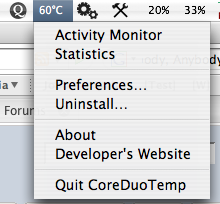Got a tip for us?
Let us know
Become a MacRumors Supporter for $50/year with no ads, ability to filter front page stories, and private forums.
How do I check system performance on osx?
- Thread starter Khurram
- Start date
- Sort by reaction score
You are using an out of date browser. It may not display this or other websites correctly.
You should upgrade or use an alternative browser.
You should upgrade or use an alternative browser.
Khurram said:Is there a "system" view where I can check the system usage/ram usage, and overall system performance?
I can't seem to find it.
thanks
It's called Activity Monitor...
Mitthrawnuruodo said:/Applications/Utilities/Activity Monitor.app
Thanks guys,
also I just dowloaded core2duo temp and installed it by default in the apps folder, but when I double click on it or try to open it , nothing happens...is it running somewhere I dont realize?
Khurram said:Thanks guys,
also I just dowloaded core2duo temp and installed it by default in the apps folder, but when I double click on it or try to open it , nothing happens...is it running somewhere I dont realize?
Sorry I'm on a PB, so I can't install this software to take a look. I'm sure someone with a compatible system who's used that particular program will be along shortly
DwightSchrute said:What's the difference between free, wired, and active memory?
Mac OS X: Reading system memory usage in Activity MonitorWired memory
This information can't be cached to disk, so it must stay in RAM. The amount depends on what applications you are using.
Active memory
This information is currently in RAM and actively being used.
Inactive memory
This information is no longer being used and has been cached to disk, but it will remain in RAM until another application needs the space. Leaving this information in RAM is to your advantage if you (or a client of your computer) come back to it later.
Free memory
This memory is not being used.
What does all this mean?
This means you shouldn't worry when the Free memory is low. The only time Free memory should be high is right after the computer starts up. As you use applications or services, memory is used and transitions to Inactive. Applications that need more memory will take from the Inactive, but the Inactive is there just in case you need it again. If the combination of Free and Inactive is very low, then you might need more memory.
I launched activity monitor and in the system memory tab, there's a setence says
VM: 11.5 GB
Does VM mean virtual memory? If thats what it means, then y i am using virtual memory b/c I am having 1gig of ram?
VM: 11.5 GB
Does VM mean virtual memory? If thats what it means, then y i am using virtual memory b/c I am having 1gig of ram?
squirrelonfire said:I launched activity monitor and in the system memory tab, there's a setence says
VM: 11.5 GB
Does VM mean virtual memory? If thats what it means, then y i am using virtual memory b/c I am having 1gig of ram?
Mac OS X: Reading system memory usage in Activity Monitor (You guessed right, it's the same article as quoted just a couple of posts aboveThe "VM size" refers to virtual memory, a system of putting information in RAM or caching it to your hard disk as needed. Thus Mac OS X can "virtually" use more memory than the amount of RAM you have. The hard disk is much slower than RAM, so the virtual memory system automatically distributes information between disk space and RAM for efficient performance. "Page ins/outs" refers to the number of times Mac OS X has moved information between RAM and disk space.
I ran Activity Monitor and where it says page in/out my number is like this
25611/0.
However I still want to know if I can reduce the Virtual memory size to like 1gig b/c i'm installing another gig of ram, that will boost my macbook to 2gig, I can barely think why should I need to use virtual memory at all.
25611/0.
However I still want to know if I can reduce the Virtual memory size to like 1gig b/c i'm installing another gig of ram, that will boost my macbook to 2gig, I can barely think why should I need to use virtual memory at all.
Mitthrawnuruodo said:
What are the other apps you are running in your menu bar?
These programs are running on my menu bar Finder, Dashboard, Fetch (a FTP program), Firefox, iChat, iTunes, Stickies Note, iWeb, system preferences, Word, and Serial Box.
Just for your information, may be just in my case, CoredueTemp quit unexpectedly on me, when it get reopened, it didn't even run b/c it said some kind of module it couldnt' read.
Just for your information, may be just in my case, CoredueTemp quit unexpectedly on me, when it get reopened, it didn't even run b/c it said some kind of module it couldnt' read.
Register on MacRumors! This sidebar will go away, and you'll see fewer ads.


